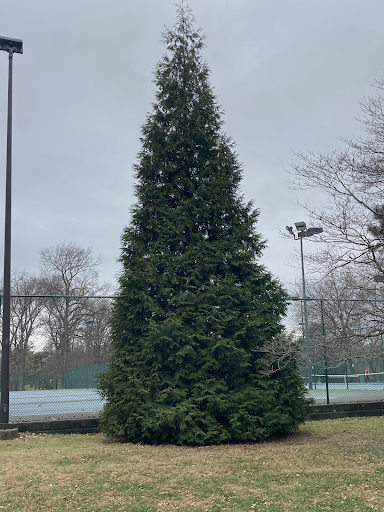By: Mark Halpin, Forestry Manager
Arborvitae (“tree of life”, unusual for having a Latin common name) refers to a number of trees in the Thuja genus. In St. Louis this usually means Thuja occidentalis, eastern white cedar, and T. plicata, western red cedar, commonly seen hybridized with the Japanese T. standishii as the ‘Green Giant’ cultivar. Arborvitae is one of the most popular (or in less polite terms, grossly overused) landscape plants on Earth and cultivars of its various species would require a complete volume to discuss. The North American T. occidentalis was growing in European gardens less than a century after Columbus first landed in Hispaniola, and its popularity has steadily increased in the ensuing centuries. It is the go-to plant for evergreen hedges, where specimens are typically planted far too close together and become ratty as they grow into each other, shading out their neighbors and increasing pest issues by cutting off valuable air movement. Patience is important in establishing a hedge.
No species is native to our area, with the smaller (60 feet or less) T. occidentalis being a tree of the Great Lakes region across to the Canadian Maritime provinces, and T. plicata (230 feet!) mainly of the Pacific Northwest. These regions are broadly similar – cool, misty, with potential for heavy snowfall and short, mild summers – and not anything like our region. Which makes it all the more surprising that Thujas are as successful here as they are. They are susceptible to the “classic” maladies of evergreens in our area – winter burn due to dry soil and desiccating winds, leaf blights and leaf miners, and breakage from ice loads. Adequate water and a protected location will help. The big headache though, are the bagworms (not to be confused with tent caterpillars or fall webworm – bagworms form small cocoons that resemble miniature pine cones).
Bagworms have a complicated life cycle, but the average gardener need only remember this: they can absolutely kill off an entire tree or even massive hedge, sometimes in one season, and they can only be sprayed for a very brief window of time, usually in June. Managing them is best done with scouting and manual removal – populations controlled and kept in check are only a minor nuisance. If you’re growing Thuja, or Juniperus, late May-July is bagworm scouting time. Just a few minutes a week will pay dividends later. Pull the developing bags off and get them far away (or if you really want to be thorough, squeeze them to pop the worms inside. You’ll want to do it away from your clothes.) If you really must spray them, do your research and get your timing right – indiscriminate spraying is cruel, wasteful, and often leads to “rebound populations” of pathogens by killing off beneficial predatory insects that normally keep them in check.
plicata in its natural western environment offers the California redwoods serious competition as “most majestic conifer.” It has quite a storied history – it was in a “canoe cedar” dugout that Lewis and Clark floated down the mighty Columbia river to the Pacific ocean. The famous Totem Poles of the Pacific Northwest were preferentially carved from this wood, as it is both light and soft, as well as strong and rot-resistant. Strangely enough, one of the functions of totem poles was to publicly mock debtors. If and when they managed to pay off their debt, they were allowed to remove and destroy the “shame pole” as a consolation prize. That seems like an appropriately humorous note to end on this week…
Pictured: Most likely a ‘Green Giant’, the brilliant emerald foliage stands in stark relief to the drab landscape of late fall. Hence ‘tree of life’ – the tree that never undergoes the temporary winter death of deciduous trees.




